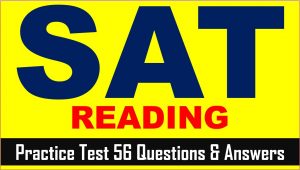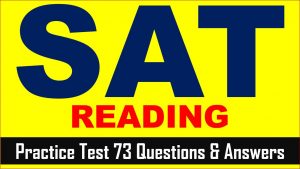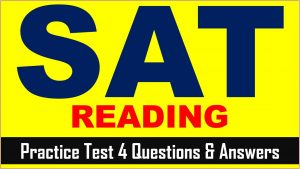SAT (Scholastic Assessment Test) is a standard test, used for taking admission to undergraduate programs of universities or colleges of the United States. SAT is developed and published by the College Board, an organization in the United States, administered by the Educational Testing Service. In this article of AKVTutorials, you will get SAT Reading Practice Online Test 50 | SAT 2024 Online Tutor AMBiPi.
SAT Reading Practice Passage
This passage is adapted from Peter A. Ensminger, Life Under the Sun. ©2001 by Peter A. Ensminger.
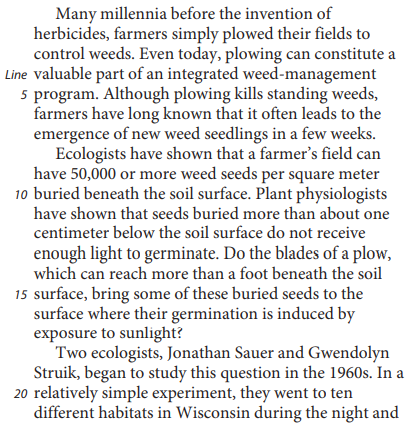
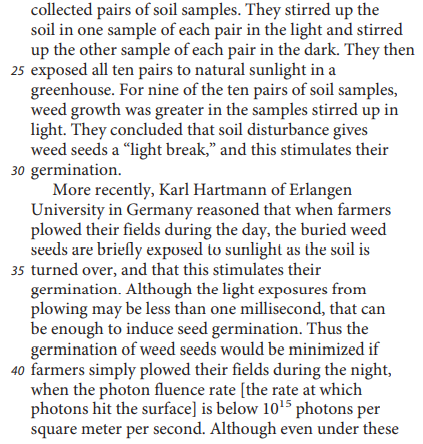
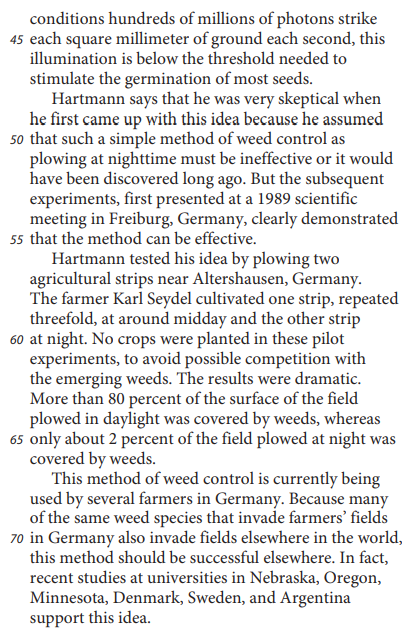
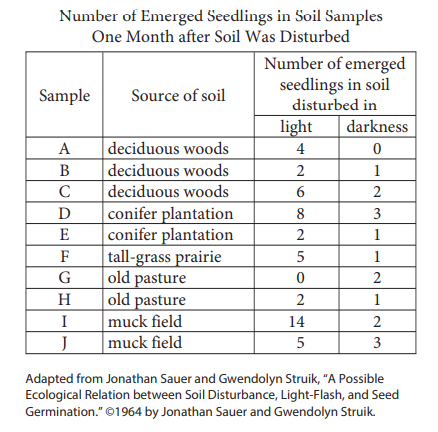
SAT Reading Comprehension Practice Test Questions
SAT Practice Test 50 Question No 1
According to the passage, exposure to light allows seeds to
Option A: begin to develop.
Option B: absorb necessary nutrients.
Option C: withstand extreme temperatures.
Option D: achieve maximum growth.
SAT Practice Test 50 Answer No 1
Show/Hide Answer
Option A :
The passage summarizes research on the relationship between plowing and weed growth. According to the fourth paragraph, the research of Karl Hartmann suggests that plowing fields during the day leads to weed growth because exposure to even small amounts of light can “induce seed germination,” or cause seeds to sprout. Thus, according to the passage, exposure to light allows seeds to begin to develop.
Choices B and D are incorrect because the passage indicates that small amounts of light cause seeds to sprout, but it doesn’t explicitly assert that light exposure allows seeds to absorb necessary nutrients (choice B) and doesn’t discuss whether light exposure helps seeds achieve maximum growth (choice D). Choice C is incorrect because the passage doesn’t indicate that light exposure can help seeds withstand extreme temperatures.
SAT Practice Test 50 Question No 2
The question in the second paragraph (lines 13-17) primarily serves to
Option A: emphasize the provisional nature of the findings discussed in the passage.
Option B: introduce the specific research topic addressed in the passage.
Option C: suggest the hypothetical impact of the studies analyzed in the passage.
Option D: indicate the level of disagreement about the methods explored in the passage.
SAT Practice Test 50 Answer No 2
Show/Hide Answer
Option B :
In the second paragraph of the passage, the following question is posed: “Do the blades of a plow, which can reach more than a foot beneath the soil surface, bring some of these buried seeds to the surface where their germination is induced by exposure to sunlight?” The passage goes on to describe research conducted both in the laboratory and in the field that sought to answer this question. Hence the question in the second paragraph primarily serves to introduce the specific research topic addressed in the passage.
Choice A is incorrect because the question in the second paragraph doesn’t primarily serve to emphasize the provisional nature of the findings discussed in the passage. Sauer and Struik’s 1960s lab experiments, described in the third paragraph, produced findings that could be characterized as provisional; however, Karl Hartmann’s research described in the fourth paragraph demonstrated that plowing at night can be an effective way to reduce weed growth. Choice C is incorrect because the impact of the studies analyzed in the passage has been real and practical, not hypothetical. Choice D is incorrect because the question in the second paragraph doesn’t indicate that there is any significant disagreement about the methods explored in the passage.
SAT Practice Test 50 Question No 3
As used in line 16, “induced” most nearly means
Option A: lured.
Option B: established.
Option C: convinced.
Option D: stimulated.
SAT Practice Test 50 Answer No 3
Show/Hide Answer
Option D :
The last sentence of the second paragraph asks, “Do the blades of a plow . . . bring some of these buried seeds to the surface where their germination is induced by exposure to sunlight?” In other words, does some farm equipment bring buried seeds to the surface where their sprouting is stimulated, or activated, by exposure to sunlight? Therefore, in the context of the passage, the word “induced” most nearly means stimulated.
Choices A, B, and C are incorrect because in the context of the passage, “induced” most nearly means stimulated, not lured (choice A), established (choice B), or convinced (choice C).
SAT Practice Test 50 Question No 4
Which choice best supports the idea that seeds present in fields plowed at night are exposed to some amount of light?
Option A: Lines 31-36 (“More… germination”)
Option B: Lines 36-38 (“Although… germination”)
Option C: Lines 43-47 (“Although… seeds”)
Option D: Lines 48-52 (“Hartmann… ago”)
SAT Practice Test 50 Answer No 4
Show/Hide Answer
Option C :
The question asks which selection from the passage best supports the idea that seeds present in fields plowed at night are exposed to some amount of light. The fourth paragraph asserts that plowing at night can reduce the germination of weed seeds. The paragraph concludes that “although even under these conditions hundreds of millions of photons strike each square millimeter of ground each second, this illumination is below the threshold needed to stimulate the germination of most seeds.” Thus this sentence best supports the idea that seeds present in fields plowed at night are exposed to some amount of light.
Choices A, B, and D are incorrect because the cited lines don’t provide the best support for the idea that seeds present in fields plowed at night are exposed to some amount of light. Instead, they relay Hartmann’s initial reasoning about seed exposure to light in fields plowed during the day (choice A), affirm that even minute durations of sunlight exposure can induce seed germination (choice B), and explain Hartmann’s initial skepticism regarding his idea about the effectiveness of nighttime plowing as a weed deterrent (choice D).
SAT Practice Test 50 Question No 5
The passage suggests that if Seydel had planted wheat or corn on the two agricultural strips in Hartmann’s experiment, the percentage of the surface of each strip covered with weeds would likely have been
Option A: lower than the percentage that Hartmann found.
Option B: higher than the percentage that Hartmann had predicted.
Option C: nearly impossible for Hartmann to determine.
Option D: comparable to Hartmann’s original projection.
SAT Practice Test 50 Answer No 5
Show/Hide Answer
Option A :
The sixth paragraph describes an experiment conducted by Karl Hartmann with the help of farmer Karl Seydel. Seydel plowed one strip of land during the day and the other at night to see what effect this had on weed growth. However, “no crops were planted in these pilot experiments, to avoid possible competition with the emerging weeds.” Thus the passage suggests that if Seydel had planted wheat or corn on the two agricultural strips in Hartmann’s experiment, the percentage of the surface of each strip covered with weeds would likely have been lower than the percentage that Hartmann found.
Choice B is incorrect. If Seydel had planted wheat or corn crops on the two agricultural strips, the percentage of weeds wouldn’t have been higher than the percentage predicted because competition with the crops would have prevented some weed growth. Choice C is incorrect because a reduction in weed growth would have been easily observable, not nearly impossible for Hartmann to determine. Choice D is incorrect. Hartmann’s original projection was that plowing at night wouldn’t provide more effective weed control. Therefore, the dramatic drop in the percentage of weeds covering the strip plowed at night wouldn’t have been comparable with Hartmann’s original projection, regardless of whether crops were planted.
SAT Practice Test 50 Question No 6
Which choice provides the best evidence for the answer to the previous question?
Option A: Lines 56-60 (“Hartmann… night”)
Option B: Lines 60-62 (“No crops… weeds”)
Option C: Line 62 (“The results… dramatic”)
Option D: Lines 63-66 (“More… weeds”)
SAT Practice Test 50 Answer No 6
Show/Hide Answer
Option B :
The previous question asks what the passage suggests about the percentage of surface that would have been covered with weeds if Seydel had planted wheat or corn on the two agricultural strips in Hartmann’s experiment. The answer, that the percentage of the surface with weeds would have been lower than the percentage Hartmann found, which is best supported in the sixth paragraph: “No crops were planted in these pilot experiments, to avoid possible competition with the emerging weeds.”
Choices A, C, and D are incorrect because the cited lines don’t provide the best evidence for the answer to the previous question. Instead, they describe the conditions of Hartmann’s experiment (choice A), characterize the results of the experiment as dramatic (choice C), and report the results of the experiment (choice D).
SAT Practice Test 50 Question No 7
As used in line 62, “dramatic” most nearly means
Option A: theatrical.
Option B: sudden.
Option C: impressive.
Option D: emotional.
SAT Practice Test 50 Answer No 7
Show/Hide Answer
Option C :
The sixth paragraph states, about Hartmann’s experiment, “The results were dramatic. More than 80 percent of the surface of the field plowed in daylight was covered by weeds, whereas only about 2 percent of the field plowed at night was covered by weeds.” In other words, the outcome of the experiment was impressive, or striking. Therefore, in the context of the passage, the word “dramatic” most nearly means impressive.
Choices A, B, and D are incorrect because, in the context of the passage, “dramatic” most nearly means impressive, not theatrical (choice A), sudden (choice B), or emotional (choice D).
SAT Practice Test 50 Question No 8
According to the table, in which soil sample disturbed in darkness did the fewest number of seedlings emerge?
Option A: Sample A
Option B: Sample B
Option C: Sample C
Option D: Sample D
SAT Practice Test 50 Answer No 8
Show/Hide Answer
Option A :
According to the table, 0 weed seedlings emerged in sample A when the soil was disturbed in darkness. This is the lowest number of seedlings recorded among all the samples in the table when the soil was disturbed in darkness.
Choices B, C, and D are incorrect because sample B (choice B), sample C (choice C), and sample D (choice D) had 1, 2, and 3 seedlings emerge, respectively, when the soil was disturbed in darkness. These totals are all greater than 0, the number of seedlings that emerged from sample A when the soil was disturbed in darkness.
SAT Practice Test 50 Question No 9
As presented in the table, which sample produced the most seedlings when the soil was disturbed in the light?
Option A: Sample G
Option B: Sample H
Option C: Sample I
Option D: Sample J
SAT Practice Test 50 Answer No 9
Show/Hide Answer
Option C :
According to the table, 14 weed seedlings emerged in sample I when the soil was disturbed in light. This is the highest number of seedlings recorded among all the samples in the table when the soil was disturbed in light.
Choices A, B, and D are incorrect because sample G (choice A), sample H (choice B), and sample J (choice D) had 0, 2, and 5 seedlings emerge, respectively, when the soil was disturbed in light. This is less than the 14 seedlings that emerged from sample I when the soil was disturbed in light.
SAT Practice Test 50 Question No 10
The data presented in the table most directly support which claim from the passage?
Option A: Lines 1-3 (“Many… weeds”)
Option B: Lines 8-10 (“Ecologists… surface”)
Option C: Lines 10-13 (“Plant… germinate”)
Option D: Lines 38-43 (“Thus… second”)
SAT Practice Test 50 Answer No 10
Show/Hide Answer
Option D :
The data presented in the table show that in nine of the ten soil samples studied, fewer weeds grew in the soil when it was disturbed in darkness than when it was disturbed in light. The fourth paragraph relays Karl Hartmann’s hypothesis based on Sauer and Struik’s studies of weed growth in the 1960s: “Thus the germination of weed seeds would be minimized if farmers simply plowed their fields during the night when the photon fluence rate [the rate at which photons hit the surface] is below 1015 photons per square meter per second.” Therefore, the data presented in the table most directly support the claim made in the fourth paragraph of the passage.
Choices A, B, and C are incorrect because the cited lines aren’t directly supported by the data presented in the table. While the findings in the table report on weed growth in soil stirred up during the day and night, these lines discuss the prehistoric use of plowing to control weeds (choice A), the number of weed seeds buried beneath the soil surface (choice B), and the depth at which seeds are buried that prevents them from germinating (choice C).

